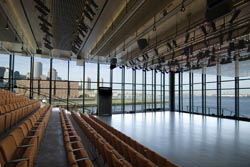- BOSTON, MA-The Institute of Contemporary Arts sits at the water's edge in Boston Harbor, at a site that will be the cultural cornerstone of a new development project for the area. The ICA has four public levels that fold ribbon-form, one on top of the other, starting with a stand of outdoor wooden bleachers that overlooks the water. On the second and third levels is the 325-seat Barbara Lee Family Foundation Theater. JaffeHolden provided the base building architectural acoustics and designed the performance audio system for the theater.
JaffeHolden provided the base building architectural acoustics and designed the performance audio system, featuring EAW loudspeakers, for the 325-seat Barbara Lee Family Foundation Theater.
The floor, back wall and ceiling of the theater on the second and third floors are created by extending the wood HarborWalk from the waterfront, up to the public bleacher seats and into the building. The remaining walls are glazed in clear glass, allowing the harbor view to become a central feature of the space. The glass walls can be controlled-from full transparency, to filtered light and no view, to total blackout-to meet performance needs.
JaffeHolden principal Russ Cooper and project manager Jerome Smith addressed the acoustical challenges of the glass walls with a system of sound absorbing banners that can be used during performances to reduce harsh reflections off the glass from amplified sound. The resultant construction was a composite glass sandwich incorporating a thick laminated glazing, airspace, and another layer of glazing. Special acoustical details at all of the glazing joints and framing were also implemented to limit sound leaks through the more lightweight portions of the assembly.
JaffeHolden's David LaDue designed the performance sound and audio infrastructure systems to provide not only high quality sound, but flexibility allowing the system to meet its highly varied programming needs. The primary reinforcement consists of a left, center, right loudspeaker system from EAW accompanied by two low frequency EAW MK2264 subwoofers. The fact that two of the theater's walls were comprised almost entirely of glass presented a number of challenges.
"Generally, the key to dealing with glass from a sound standpoint is to avoid it," noted LaDue. "Meaning, you want to keep the sound from hitting the glass wherever possible, thus avoiding undesirable reflections and increased reverberance." To achieve this he selected loudspeakers with special consideration given to their pattern control, relative to the loudspeaker/glass/audience physical relationship.










